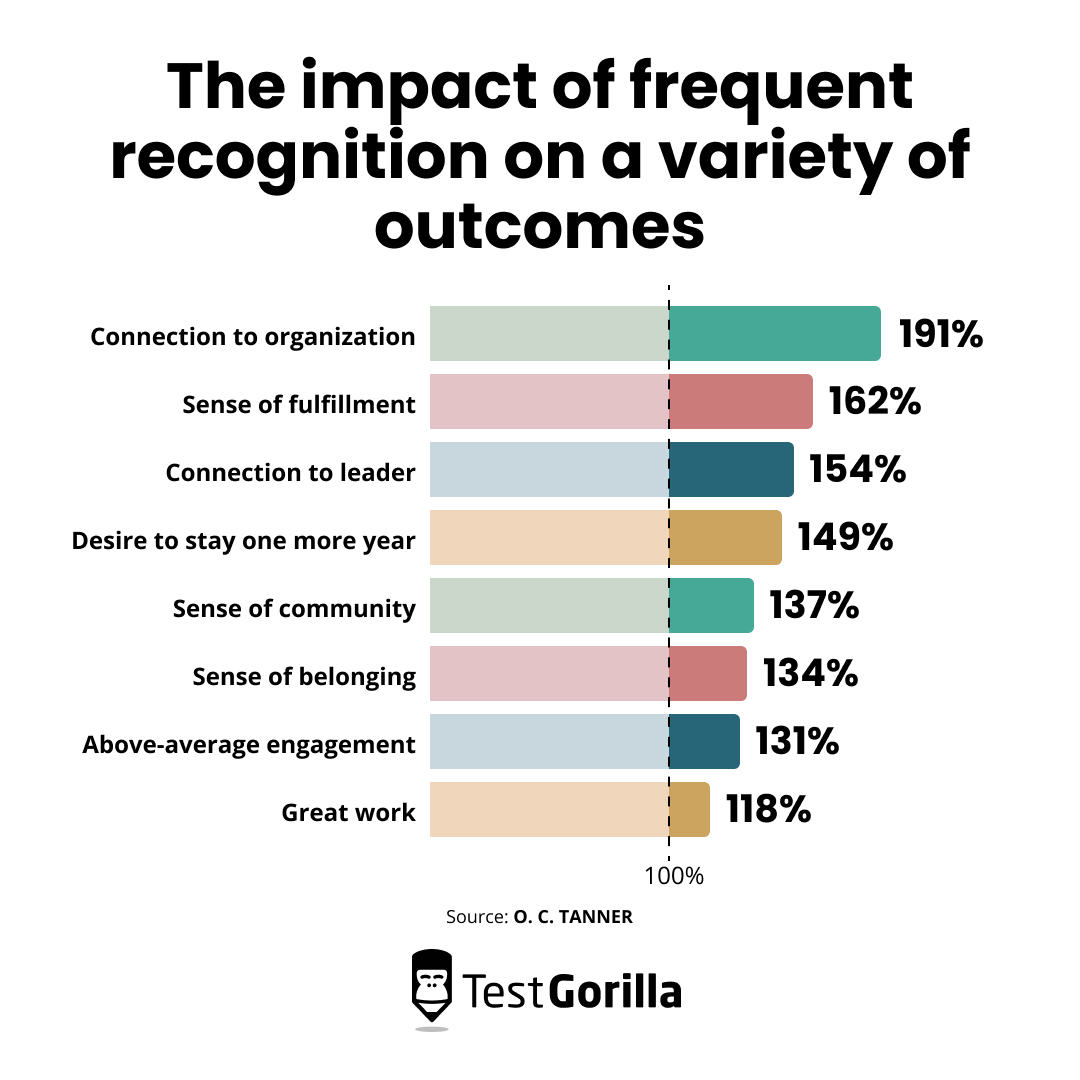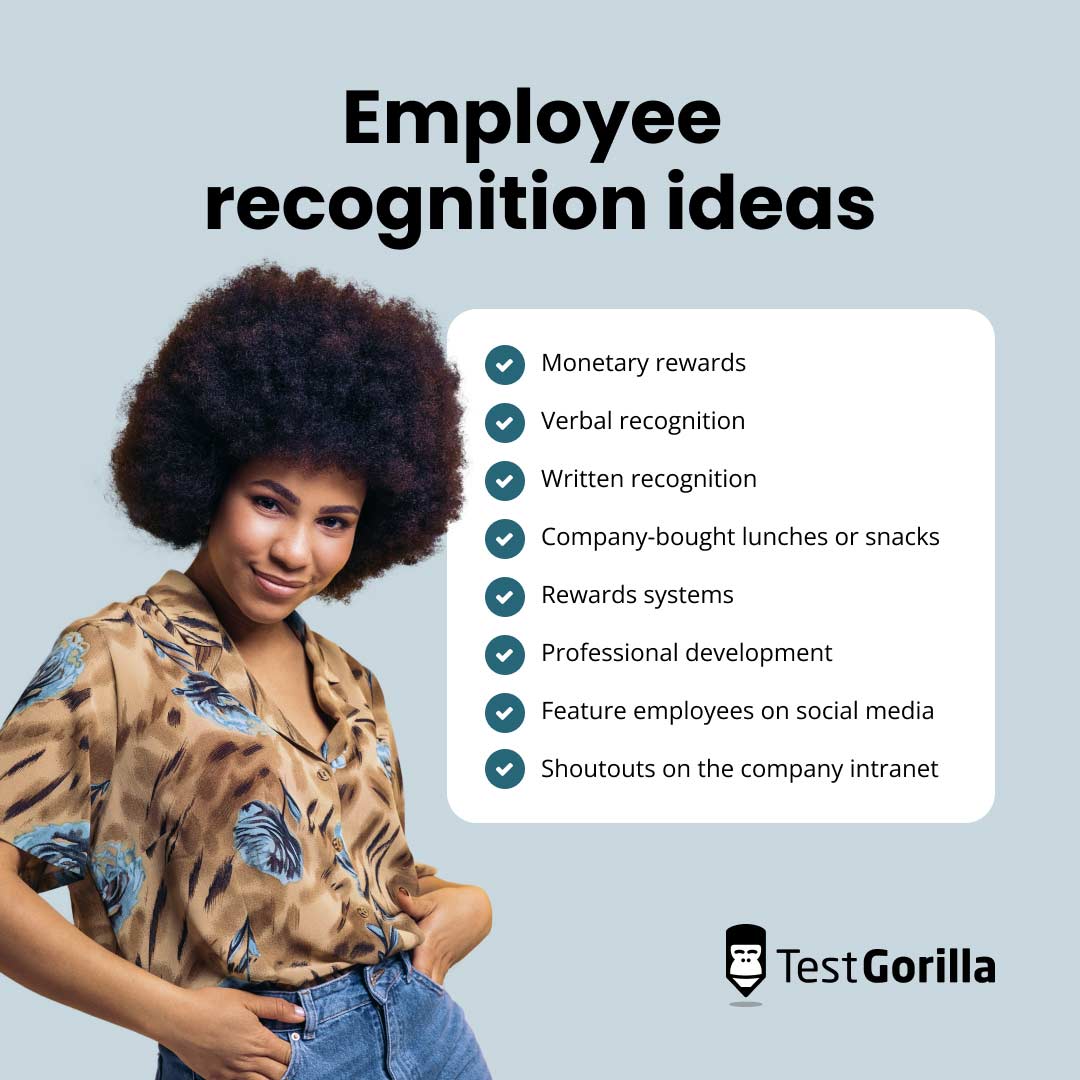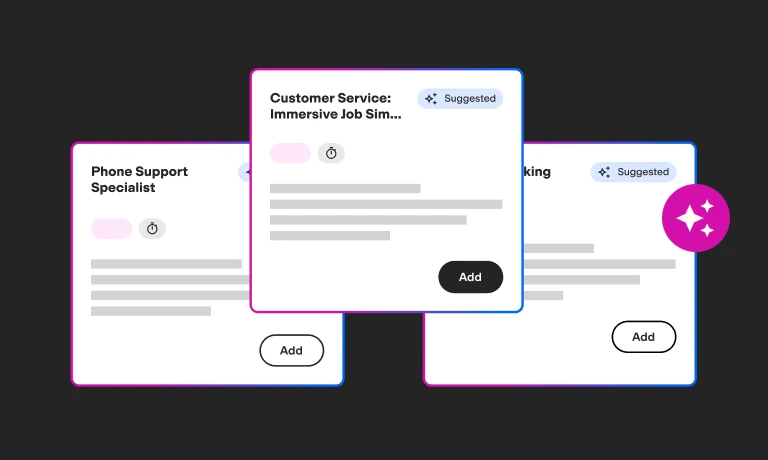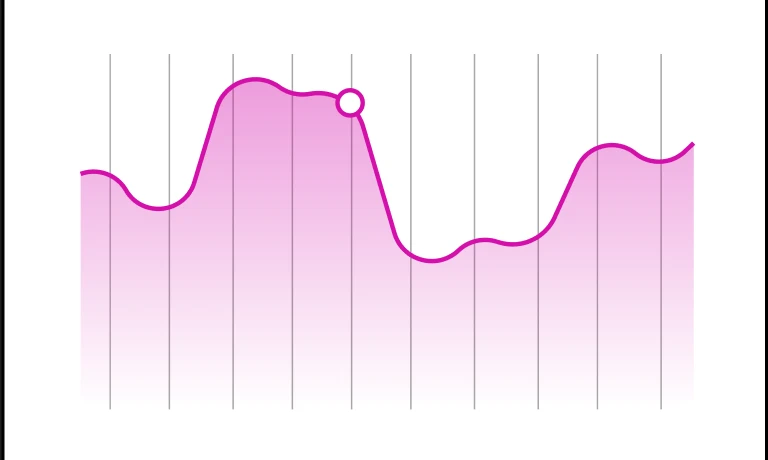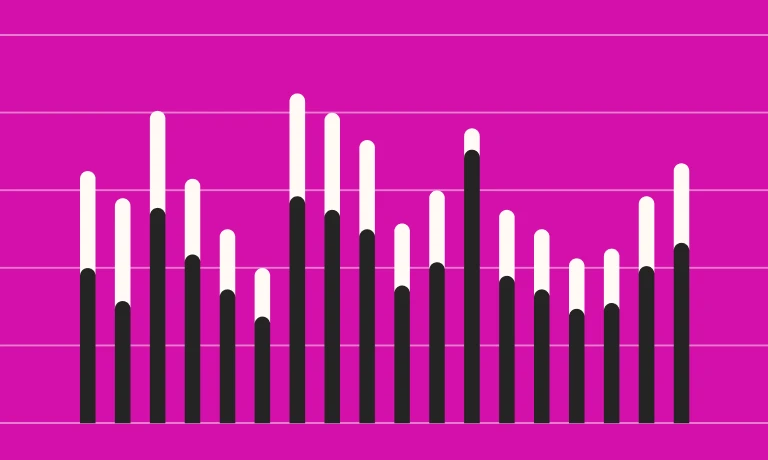Employee recognition: Leverage this retention strategy and celebrate your people
Employee recognition is essential for a healthy, functioning workplace. One study found it was the most prominent driver of hard work, even more than increased pay and learning opportunities.[1]
This recognition can be monetary, like gift cards and bonuses, or non-monetary, like shoutouts, professional development opportunities, or even a simple thank you card.
Top talent is hard to come by, which makes recognition more important than ever.
Companies must show their employees they’re valued and appreciated, or they are likely to look elsewhere for work.
Therefore, employee recognition is an excellent employee retention strategy.
Proper recognition also boosts motivation, improves collaboration, and nurtures a positive environment.
This blog discusses the importance of employee recognition in the workplace and details how to retain top performers by appreciating their efforts.
Table of contents
- What is employee recognition?
- The importance of employee recognition
- The benefits of employee recognition
- Employee recognition ideas: 7 examples
- 8 best practices for leveraging employee recognition to retain your best performers
- 3 examples of companies succeeding with employee recognition programs as a talent retention strategy
- Focus your employee recognition on skills and abilities
What is employee recognition?
Employee recognition is acknowledging and appreciating a person’s efforts, behavior, or results. This appreciation usually comes when an employee exceeds base expectations and supports a company’s values or goals.
We can’t overstate the importance of employee recognition. Organizations must show appreciation for employee contributions to maintain productivity and reduce employee turnover rates.
Employees don’t want to be a part of a company that doesn’t take the time to appreciate its people’s hard work.
Recognition is a powerful tool to enhance your workforce, build a stronger company culture, and enable you to take advantage of important employee retention trends.
These trends, like supporting employee wellbeing and mental health, can further enrich your company.
The importance of employee recognition
In the modern era, the working world intensely focuses on retaining and engaging talent, largely because of an ongoing skills shortage and the greater emphasis companies put on employee health and wellbeing.
Companies must prioritize their employees because it’s becoming the norm for employees to prioritize themselves.
It’s crucial to recognize employees and not treat them like a “cog in the machine.” More organizations are taking notice, implementing more recognition programs, and seeing great results.
Successful employee recognition programs greatly affect:
Sense of belonging
Connection to organization
Sense of fulfillment
Connection to leader
Sense of community
Work ethic
Desire to stay longer
Gary Beckstrand, a vice president at O.C. Tanner, believes that most employee desires boil down to a more fulfilling experience and that fulfillment, or a lack thereof, is one of the primary reasons employees choose to leave or stay.
Here are a few reasons why employers should take the time to recognize their workers:
Encourages great performance: When employees know that what they’re doing is appreciated, they’re more likely to continue to do it or try even harder
Builds a healthier culture: Employees who feel valued are more positive, motivated, and engaged, leading to a healthier work environment with more peer recognition
Makes you an attractive employer: An organization that authentically recognizes its people is valuable to current and potential employees
Employees build better relationships with each other: When recognition is frequent and inclusive, it leads to less resentment and better collaboration
Employee rewards and recognition are extremely important to your workforce.
This appreciation helps prevent detrimental burnout, stress, and anxiety – especially for larger projects because employees are likely to be exhausted and need the kudos.
Special attention to recognition also helps diversity in the workplace thrive. When employers issue recognition without thought, it doesn’t serve the needs of diverse employees.
Customizing your employee recognition programs enables you to tailor them to a diverse team of employees. For a closer look into the impact and importance of recognition, check out these employee recognition statistics.
The best insights on HR and recruitment, delivered to your inbox.
Biweekly updates. No spam. Unsubscribe any time.
The benefits of employee recognition
Successful employee recognition programs engage employees and connect them to their work, which builds an environment where people want to work.
Let’s look at the top benefits of effective employee recognition, including increased performance and retention.
1. Increases employee retention
Employee recognition shows that an organization cares, and employers notice hard work and accomplishments, which has a positive impact on employee retention rates.
People have always craved authentic recognition, but it has become non-negotiable in an era where employees prioritize their wellbeing. Without the right recognition, workers are likely to start job hunting.
However, employees who have their work recognized or celebrated more than four times each year have a 96% retention rate.
Further, organizations with roughly 10,000 employees save $16.1m in turnover costs when they make recognition a core part of their culture.
Recognition is not a pat on the back.
Recognition for your effort and skills builds a more fulfilling employee experience, affecting the entire employee lifecycle.
2. Reduces burnout and increases engagement
Employee rewards and recognition motivate people, increasing employee engagement and reducing burnout.
Recognition is one of the largest motivators – 37% of workers say recognition motivates their hard work, more than factors like autonomy (12%) and pay increases (7%).[1]
Moreover, the same Gallup study above shows that employees who receive excellent recognition are 20 times more likely to be engaged than employees who receive poor recognition.
A culture of recognition also helps reduce damaging employee burnout. One of the largest causes of burnout is a toxic workplace that a culture of appreciation prevents.
A reduction in receiving recognition increases the likelihood of burnout by 48%, and when a company has no consistent recognition strategy, it increases it by a further 29%.
3. Boosts productivity
The extra engagement people receive from employee recognition programs connects them to their work. This effect is similar to the outcome of solid employee coaching – spending a little extra time on your people goes a long way.
It also lets them know that their effort isn’t going unnoticed, and when employees believe they aren’t appreciated, they often resort to doing the bare minimum..
However, authentic recognition causes a 69% increase in the likelihood of employees putting in extra effort and positively affects your employee attrition rate.[1]
Although companies sometimes must do layoffs regardless of performance, this increased productivity can reduce the amount of workers you need to let go of overall.
4. Increases performance
Now, let’s put it all together. Recognition increases engagement, leading to greater productivity and affecting business performance.
Organizations with recognition programs have 14% higher engagement, productivity, and performance than companies without recognition.
The increase in engagement alone impacts your bottom line – a simple 15% improvement in engagement can result in a 2% increase in margins.[2]
The same study also found that some employee recognition programs don’t see these results because many programs focus too heavily on monetary rewards, which not all employees appreciate.
Many people crave other rewards more because work also impacts employee morale and work culture.
Learning opportunities, professional introductions, and genuine gratitude are worth more than bonuses to some employees.
Let’s take a look at some ideas for employee recognition next.
Employee recognition ideas: 7 examples
There are many different ways to appreciate and recognize employees, depending on your employees’ preferences and your company’s resources.
If you have a remote work policy, you can also personalize ideas to work for a distributed workforce.
Here are a few different employee recognition examples:
Types of employee recognition | Description |
1. Monetary rewards | A form of recognition that includes gift cards and bonuses. |
2. Verbal recognition | Perks like verbal gratitude, positive feedback, and praise, usually in person or weekly huddles via video call. |
3. Written recognition | This reward is formal recognition in written form, usually as a handwritten note or via group chat. |
4. Company-bought lunches or snacks | These rewards are a form of social recognition that includes everyone on a team, like buying a pizza for the break room. |
5. Rewards systems | These systems are programs that boost morale, and employees sign up for them, usually earning points and redeeming them for gifts. |
6. Professional development | Offer employees courses or build them professional development plans. Some companies even support full academic programs, such as a Master of Business Administration (MBA). |
7. Feature employees on social media | Featuring an appreciation post on LinkedIn or Instagram to display a worker becoming “employee of the month” or highlighting a stellar team effort |
8. Shoutouts on the company intranet | A quick way to recognize employees over your virtual workspace on their birthdays, work anniversaries, or day-to-day milestones |
These employee recognition ideas improve employee motivation and team-building initiatives. We encourage you to try a few of them.
They’re also all excellent additions to your employee incentive program.
Now that we have some employee recognition examples, let’s learn how to use them.
8 best practices for leveraging employee recognition to retain your best performers
Employee recognition efforts are essential for a healthy company and don’t have to be difficult. Using the right strategies makes the process effective and natural.
Let’s look at the top tactics – including promoting peer recognition and leveraging employee surveys – for increasing satisfaction and reducing voluntary turnover.
Strategies for recognizing employees: A summary
Strategy | What it accomplishes |
1. Celebrate large and small achievements | Ensures everyone receives recognition and small but meaningful tasks receive praise |
2. Encourage specific, relevant recognition | Shows employees that you’re paying attention to them specifically, not doling out praise “across the board” |
3. Promote peer-to-peer recognition | Encourages a culture of recognition where every individual supports one another |
4. Recognize employees for their skills and contributions | Ensures that people are recognized for more than tenure, nurturing an inclusive culture |
5. Build an employee recognition program | Standardizes recognition to create a more even system |
6. Use employee surveys to find out how your people want to be recognized | Discovers employee preferences and needs, leading to more effective recognition |
7. Use different types of recognition | Personalizes employee recognition so each person gets something they appreciate |
8. Encourage leaders to recognize their people | Motivates employees and increases their trust in the organization |
1. Celebrate large and small achievements
Many companies forget that you can recognize any achievement, praising only large projects and rockstar performances.
You must remember to give kudos for the little things.
An example would be an employee going the extra mile by volunteering for a task the manager needs to redistribute from someone else’s workload. This task could be small and only take a few hours, but it’s crucial to recognize it, even with a simple “thank you.”
Saying thanks is one of the most impactful ways to practice employee recognition and make people feel valued, and it’s one of the easiest and most affordable methods to use.
Praising large and small accomplishments also helps you practice inclusive recognition, recognizing every employee.
Some employees may never be a part of monumental projects, but you should still recognize them for their hard work, dedication, and skills.
2. Encourage specific, relevant recognition
Employees need authentic recognition. People can tell when words are meaningless.
Of employees who receive insincere recognition at work, only 8% strongly agree that they receive respect.[3]
Your recognition must be specific and relevant – generic programs don’t do the trick.
Here are a few specific employee recognition examples:
“Thank you for your dedication during this project. You’re a major factor in why we completed this before the deadline.”
“You’ve been working hard to coach our new hires, and it shows. You’re a great mentor.”
“Thank you for mediating that conflict. Your patience helped diffuse the situation.”
It’s also important to ensure your recognition is timely. Giving gift cards to the sales team that exceeded quota in the past week is more meaningful than waiting until the holidays when everyone else expects a reward.
Prompt recognition also helps reinforce good behaviors and build better skills.
For example, if a manager tells a customer success agent that they loved how they handled a heated situation in their next one on one meeting, the employee can start honing those skills and using them more often.
3. Promote peer-to-peer recognition
Employee recognition in the workplace is more natural when woven into your organizational culture, so everyone in your team practices it.
We recommend building a peer to peer recognition culture where employees are encouraged to praise and uplift each other.
This recognition can be as simple as a team shoutout channel on Slack or an entire employee recognition board in a physical office. You can also leverage employee recognition platforms to make this process even easier.
Encourage peer-to-peer recognition to build a healthy work environment and promote better teamwork, collaboration, and working relationships.
It also helps bridge the gap in recognition. Managers don’t have the time to recognize every employee for all their good work, so a lot of effort goes unnoticed. Encouraging colleagues to step up and commend great work helps fewer contributions slip through the cracks.
4. Recognize employees for their skills and contributions
Successful employee recognition programs are inclusive, meaning everyone on the team gets appreciation regardless of status, socioeconomic background, gender, race, or orientation.
This key component builds an inclusive culture, a vital retention strategy.
Promote this type of environment by adopting a skills-first mindset. A skills-based organization takes the focus off of connections and tenure, which are often heavily considered when recognizing employees.
Some companies solely focus on recognition for long-term employees and rarely consider skilled newcomers.
One way to encourage a skills-based mindset is by adopting talent assessment tests, which help people start looking at others for their contributions and capabilities.
5. Build an employee recognition program
Employee recognition is equal and more inclusive when standardized, and you can do that with employee recognition programs.
Recognition needs to be simple so managers can use it easily. You should also standardize it so all employees receive similar recognition.
For example, you wouldn’t want one employee to receive hockey tickets and another to receive a coffee mug. This uneven distribution can quickly cause resentment instead of your intended engagement.
Here’s a quick run-through of how to build an employee recognition program:
Define business goals
Determine objectives and ensure they align with your culture
Determine your budget
Standardize your policies, such as which behavior to reward and what the rewards are
Introduce the program
Measure results
Please note that your program needs to be standardized and flexible. Employees have different needs, so designing a dynamic program that isn’t one-size-fits-all is important.
You can better manage this program with the right tools. For more information, check out our guide on employee recognition software.
6. Use employee surveys to find out how your people want to be recognized
Adopt employee listening in your company to discover how your people want to be recognized, and then personalize your employee recognition programs.
Find this important information by leveraging employee surveys or asking people about it during stay interviews.
Recognition only has the power and benefits listed above if employees want and value it.
People have varied appreciation languages: One person may want a gift, and another prefers a compliment.
For example, if the majority of your employees aren’t married or in relationships, they may not appreciate vouchers for a romantic dinner.
These surveys help you determine the types of recognition people want and also personal preferences. For example, introverts may not like flashy, public recognition and would prefer low-key things.
Surveys also help you collect upward feedback about your programs and changes you could make, such as which type of behavior gets recognized.
7. Use different types of recognition
Now that your survey results are in, it’s time to use various recognition methods.
It’s critical to get to know your employees and customize your recognition. Having different types at your fingertips facilitates this.
Consider a variety of employee recognition awards, monetary and non-monetary, such as gift cards, group lunches, spot awards, or social shoutouts.
Many people also appreciate help with work connections, so try introducing high performers to connections of yours.
Some types of recognition directly benefit your company and the worker, like employee training programs. These give people much-desired career growth and improve their job performance.
Leveraging different employee recognition awards is especially vital for a diverse workforce. For example, workplaces with generational diversity could give traditionalists handwritten notes and Gen Z’ers a social media shoutout.
8. Encourage leaders to recognize their people
Leaders must be a part of their team’s work. Employees need to know that their leadership hears them, appreciates their efforts, and values their work.
Leadership communication facilitates this bond. Encourage leaders to talk to their employees, recognize great work, and show authentic empathy.
Too often, leaders only recognize big wins and grand outcomes – not small victories or dedicated efforts.
What’s the difference? When you recognize the second two factors, it makes recognition more powerful:
Recognizing small victories: Increases the frequency of leadership recognition
Recognizing dedicated effort: Focuses on the skills that make hard work possible, even when it doesn’t result in a major outcome
Recognizing employee skills and commitment is already a good practice, but it’s especially impactful when it comes from leadership. It helps build employee trust, connects people to the company’s mission, and increases retention.
3 examples of companies succeeding with employee recognition programs as a talent retention strategy
Employee rewards and recognition are keen strategies, and many organizations leverage them.
Let’s take a look at three excellent real-life examples.
Companies excelling with employee recognition: A summary
Company | Why it’s successful |
Disney | Leverages a wide range of recognition programs to appreciate all employees |
Baldwin Risk Partners | Balances monetary recognition with learning opportunities |
Hewlett-Packard | Celebrates the big and the small |
Disney
Disney’s employee recognition awards are a major part of its corporate reputation. This company has five core values: safety, courtesy, show, efficiency, and inclusion, and it goes to great lengths to recognize any workers who uphold them.
Disney has many different employee recognition programs:
The Walt Disney Legacy Award, a rare award for exceptional performance
Lifetime achievement awards
The #CastCompliment initiative, which enables customers to give social media shoutouts to great employees
Recognize Now!, a peer recognition tool
One example is this employee spotlight for DiJon Bracy, who spent time recognizing his peers every week until he accumulated 10,000 notes for his colleagues. In return, he also got a social media shoutout.[4]
Disney shows that you don’t need to limit yourself to just one or two methods.
Adopt many types of recognition methods and programs, and you can appreciate a range of great work.
Baldwin Risk Partners
Baldwin Risk Partners, an insurance agency, believes you should combine monetary rewards with a warm, welcoming environment and trustworthy leadership.
This company uses equity-based employee compensation to reward great performance and the achievement of large goals. It has also won awards for its outstanding employee wellbeing and has gotten a nod for its internal mobility.[5]
Employees describe Baldwin Risk Partners’s culture as “engaging” and “genuine.”
This authentic recognition ripples out, increasing overall trust in company leadership. The team has inspiring things to say about its managers, such as this anonymous employee:
“My boss is very open to new ideas, and I feel a great deal of trust and empowerment.”
Baldwin Risk Partners is an excellent example of how to do monetary recognition right. It combines compensation with inclusivity, trust, and career growth, which helps foster a healthy culture.[6]
Hewlett-Packard
Hewlett-Packard takes employee appreciation seriously, celebrating large and small achievements alike.
This company holds an “Employee Appreciation Day” each year. This global celebration has virtual parties, cooking classes, yoga lessons, and dance classes. It’s a day where everyone pauses to appreciate every team member and thank them for their hard work.
But it’s more than just one day.
Employee Appreciation Day may be the largest celebration, but one of Hewlett-Packard’s company values is that appreciation has to be more than one day.
Recognition is a spirit and an attitude that must permeate the whole year. This company upholds that by showing appreciation, putting its team members first, and investing in its workforce.[7]
Focus your employee recognition on skills and abilities
Employee recognition in the workplace is one of the most powerful ways to attract and retain modern talent. People need to feel valued and feel their effort is appreciated.
Successful employee recognition programs leverage many ideas, personalizing recognition and ensuring each employee feels appreciated in the way that means the most to them.
We recommend inclusive recognition and valuing every employee for their skills and contributions to ensure they get their kudos, regardless of tenure.
Another great way to ensure employees feel personally recognized is with the right compensation and benefits package. For more information, read our guide on employee benefits.
If you’d like to learn more about encouraging a skills-based mindset, check out our talent assessment test library.
Sources
Hastwell, Claire. (March 2, 2023). "Creating a Culture of Recognition". Great Place To Work. Retrieved December 14, 2023. https://www.greatplacetowork.com/resources/blog/creating-a-culture-of-recognition
"Recognition programmes". Deloitte. Retrieved December 14, 2023. https://www2.deloitte.com/ie/en/pages/deloitte-private/articles/recognition-programmes.html
Maese, Ellyn; Lloyd, Camille. (July 18, 2023). "Is Your Employee Recognition Really Authentic?". Gallup. Retrieved December 14, 2023. https://www.gallup.com/workplace/508208/employee-recognition-really-authentic.aspx
Gell, Tristen. (November 13, 2021). "Spreading Kindness through Recognition at Walt Disney World Resort". Disney Parks Blog. Retrieved December 14, 2023. https://disneyparks.disney.go.com/blog/2021/11/spreading-kindness-through-recognition-at-walt-disney-world-resort/
"Baldwin Risk Partners". Top Workplaces. Retrieved December 14, 2023. https://topworkplaces.com/company/bks-baldwin-krysty/
"6 Companies with Great Employee Recognition". (October 30, 2023). Top Workplaces. Retrieved December 14, 2023. https://topworkplaces.com/companies-with-best-employee-recognition/
May, Alan. (March 5, 2021). "Employee appreciation deserves more than a day". Hewlett-Packard Enterprise. Retrieved December 14, 2023. https://www.hpe.com/us/en/newsroom/blog-post/2021/03/employee-appreciation-deserves-more-than-a-day.html
You've scrolled this far
Why not try TestGorilla for free, and see what happens when you put skills first.


